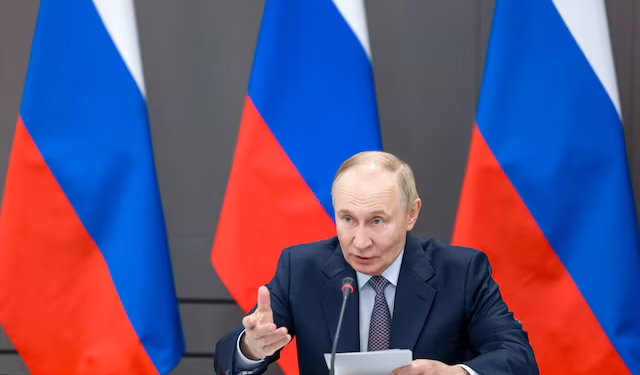“Russia is prepared to continue adhering to the central numerical limits under the New START Treaty for one year after February 5, 2026,” Putin said. “Subsequently, based on an analysis of the situation, we will make a decision on whether to maintain these voluntary, self-imposed restrictions.”
It’s a familiar script: Moscow posing as a responsible power while the world looks past its aggression in Ukraine. Putin framed his proposal as a step for “global non-proliferation” and a possible path to renewed dialogue with Washington. But he added a sharp warning: “This measure will only be viable if the United States acts in a similar manner, and does not take steps that undermine or violate the existing balance of deterrence capabilities.”
The Biden years left America with a simple choice—keep extending old treaties while Russia modernized its arsenal and expanded ties with Beijing, or begin charting a new course. President Donald Trump has already signaled he’d like to keep limits in place temporarily, but with one major difference: he insists China must be included in any future arms deal. Beijing, for now, rejects the idea outright. That refusal matters, because a nuclear accord that excludes the world’s fastest-growing military power is not much of a safeguard.
New START was originally signed in 2010 by Barack Obama and Dmitry Medvedev, and later extended by Joe Biden and Putin in 2021 for five more years—the maximum allowed. It caps each side at 1,550 deployed warheads and 700 delivery vehicles, whether missiles, submarines, or bombers. On paper, it sounds like balance. But the problem lies in trust: Russia has repeatedly violated agreements and used arms talks as bargaining chips while continuing destabilizing behavior abroad.
This latest “olive branch” also comes at a moment of pressure for Putin. Trump has made it clear he wants an end to the war in Ukraine, a conflict that has drained Moscow economically and militarily while straining East-West relations to levels not seen since the Cold War. By floating arms restraint, Putin is attempting to look reasonable internationally while continuing his brutal campaign regionally.
White House press secretary Karoline Leavitt responded that the idea sounded “pretty good,” though she noted President Trump would address the matter himself. That careful phrasing underscores what’s at stake: whether America accepts Moscow’s terms at face value or insists on an agreement that truly strengthens our national security rather than papering over threats.
Behind all the diplomatic language lies the reality that Putin is also watching America’s own defense plans closely. He pointed to U.S. efforts to improve missile defenses and proposals to deploy interceptors in space as destabilizing actions that could “nullify our efforts to maintain the status quo in the field of START.” His warning carried an unmistakable message: Russia will respond aggressively if it feels Washington is gaining a technological edge.
Konstantin Kosachyov, a senior Russian senator, echoed that line, saying on Telegram: “I hope that this signal will be heard and correctly interpreted.” In other words, Moscow wants Washington to believe cooperation is on the table—but only if America tempers its own defenses.
The broader lesson is that arms treaties are not just about numbers on a page. They are about deterrence, leverage, and trust. America has learned through decades of Cold War brinkmanship that strength keeps the peace far more reliably than paper promises. Putin’s proposal may appear like a step toward stability, but in truth it is another maneuver in a long chess game—one where the stakes are nothing less than national survival.
When Vladimir Putin steps up to a podium and offers “restraint,” history teaches us to listen with caution, not blind optimism. On Monday, the Russian president declared that Moscow would voluntarily maintain the limits on deployed strategic nuclear weapons set by the 2010 New START accord, even after the treaty expires in February 2026—so long as the United States agrees to do the same.
“Russia is prepared to continue adhering to the central numerical limits under the New START Treaty for one year after February 5, 2026,” Putin said. “Subsequently, based on an analysis of the situation, we will make a decision on whether to maintain these voluntary, self-imposed restrictions.”
It’s a familiar script: Moscow posing as a responsible power while the world looks past its aggression in Ukraine. Putin framed his proposal as a step for “global non-proliferation” and a possible path to renewed dialogue with Washington. But he added a sharp warning: “This measure will only be viable if the United States acts in a similar manner, and does not take steps that undermine or violate the existing balance of deterrence capabilities.”
The Biden years left America with a simple choice—keep extending old treaties while Russia modernized its arsenal and expanded ties with Beijing, or begin charting a new course. President Donald Trump has already signaled he’d like to keep limits in place temporarily, but with one major difference: he insists China must be included in any future arms deal. Beijing, for now, rejects the idea outright. That refusal matters, because a nuclear accord that excludes the world’s fastest-growing military power is not much of a safeguard.
New START was originally signed in 2010 by Barack Obama and Dmitry Medvedev, and later extended by Joe Biden and Putin in 2021 for five more years—the maximum allowed. It caps each side at 1,550 deployed warheads and 700 delivery vehicles, whether missiles, submarines, or bombers. On paper, it sounds like balance. But the problem lies in trust: Russia has repeatedly violated agreements and used arms talks as bargaining chips while continuing destabilizing behavior abroad.
This latest “olive branch” also comes at a moment of pressure for Putin. Trump has made it clear he wants an end to the war in Ukraine, a conflict that has drained Moscow economically and militarily while straining East-West relations to levels not seen since the Cold War. By floating arms restraint, Putin is attempting to look reasonable internationally while continuing his brutal campaign regionally.
White House press secretary Karoline Leavitt responded that the idea sounded “pretty good,” though she noted President Trump would address the matter himself. That careful phrasing underscores what’s at stake: whether America accepts Moscow’s terms at face value or insists on an agreement that truly strengthens our national security rather than papering over threats.
Behind all the diplomatic language lies the reality that Putin is also watching America’s own defense plans closely. He pointed to U.S. efforts to improve missile defenses and proposals to deploy interceptors in space as destabilizing actions that could “nullify our efforts to maintain the status quo in the field of START.” His warning carried an unmistakable message: Russia will respond aggressively if it feels Washington is gaining a technological edge.
Konstantin Kosachyov, a senior Russian senator, echoed that line, saying on Telegram: “I hope that this signal will be heard and correctly interpreted.” In other words, Moscow wants Washington to believe cooperation is on the table—but only if America tempers its own defenses.
The broader lesson is that arms treaties are not just about numbers on a page. They are about deterrence, leverage, and trust. America has learned through decades of Cold War brinkmanship that strength keeps the peace far more reliably than paper promises. Putin’s proposal may appear like a step toward stability, but in truth it is another maneuver in a long chess game—one where the stakes are nothing less than national survival.





















There’s no way that our alien friends would allow a nuclear attack. Yes, this is Chess,a very long game! Trump is letting zelensky take the beating he deserves for stalling with the peace talks. It’s Z that played games but had no strategy. I’m pretty sure that Russian forces are being humane as possible seeing Putin believes that those are his people. You have to wonder if China, Russia and the US are even investing in military equipment as the technology available today is going space age.